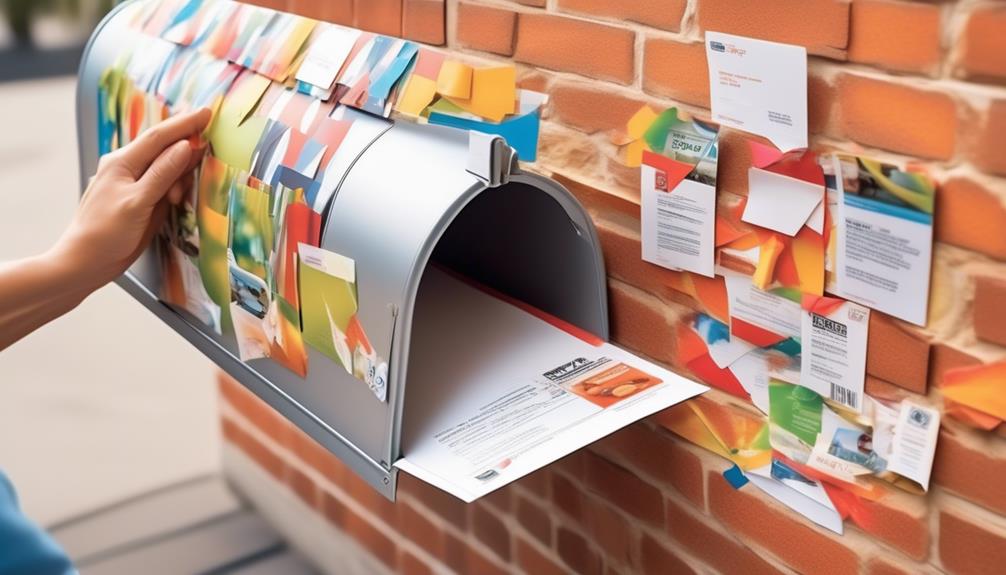To measure your email marketing ROI effectively, focus on key metrics that matter. Start with open rates, aiming for at least 20%, and enhance them with personalization. Track your click-through rates, which should ideally be between 1% and 5%, and monitor your conversion rates, targeting above 5%. Keep an eye on your bounce and list growth rates too. Don't forget to calculate your ROI using the formula: (Revenue generated – Cost of campaign) / Cost of campaign * 100. Each of these metrics gives you insights to refine your strategy and boost your results. Explore further for more essential tips!
Key Takeaways
- Open rates, typically around 20%, are influenced by subject lines and personalization, essential for measuring email campaign effectiveness.
- Click-through rates (CTR) gauge reader engagement, usually ranging from 1% to 5%, and can be improved through A/B testing.
- Conversion rates indicate the success of email campaigns in driving desired actions, with a benchmark aim of over 5% for lead-to-customer conversions.
- Revenue generation from email marketing can reach up to 4,400%, emphasizing the importance of tracking revenue per email and overall campaign costs.
- Regularly calculating ROI using the formula (Revenue generated – Cost of campaign) / Cost of campaign * 100 is crucial for evaluating email marketing success.
Key Email Marketing Metrics

When it comes to email marketing, tracking the right metrics can make or break your campaign's success. Key metrics like Open Rate, Click-Through Rate, and Conversion Rate are essential for evaluating your email performance.
The Open Rate shows how many recipients opened your email, typically averaging around 20%. Crafting compelling subject lines can greatly boost this metric, as crafting engaging subject lines can enhance your overall engagement.
The Click-Through Rate (CTR) measures engagement, indicating the percentage of readers who click on links within your email, with a benchmark of 1% to 5%.
Next up is the Conversion Rate, which tracks the percentage of recipients completing desired actions after clicking through. This metric helps you gauge the effectiveness of your calls-to-action.
You should also monitor the Bounce Rate, reflecting the percentage of emails that fail to deliver. Keeping this below 2% requires regular cleaning of your subscriber list.
Lastly, the List Growth Rate gives you insight into your audience's engagement and retention. Calculating it as (New Subscribers – Unsubscribes) / Total Subscribers x 100 is essential.
Engagement Metrics

Engagement metrics are essential for understanding how your audience interacts with your emails. By analyzing the open rate, click-through rate, and unsubscribe trends, you can gain valuable insights into the effectiveness of your content and subject lines.
Additionally, focusing on content relevance and authority can further enhance your email campaigns.
Let's explore how these metrics can guide your email marketing strategies.
Open Rate Insights
Understanding open rates is essential for evaluating the effectiveness of your email marketing campaigns. They provide insights into how well your subject lines capture attention and engage your audience.
Just like a well-crafted budget helps manage finances, an effective email strategy can enhance engagement levels. Here are four reasons why open rates matter:
- Benchmarking Success: A typical open rate benchmark is 20% to 24%, helping you gauge your email marketing efforts against industry standards.
- Subject Line Impact: Personalized subject lines can boost open rates by up to 26%, highlighting the importance of crafting compelling messages.
- Unique Opens: Focusing on unique opens allows you to understand how many individuals are engaging with your content, rather than just counting total opens.
- Engagement Metrics Nuance: With Apple's Email Privacy Protection affecting open rate accuracy for about 22% of marketers, it's vital to analyze these metrics alongside other indicators like clickthrough rates.
Keep in mind that while open rates are valuable, they can be misleading due to image-blocking in email clients.
To truly measure your email performance, consider all engagement metrics for a more holistic view of your campaigns.
Clickthrough Rate Analysis
Clickthrough rates (CTR) serve as a vital indicator of how well your audience interacts with your email content. Calculated by dividing total clicks by delivered emails and multiplying by 100, CTR provides a clear measure of engagement. A good CTR typically ranges from 1% to 5%, depending on your industry, making it essential for evaluating the effectiveness of your email campaigns.
Implementing a methodical approach to analyze these rates can greatly aid in improving your overall strategy, much like the way best practices in software quality assurance enhance product reliability.
Improving your CTR can be achieved through A/B testing various elements, including subject lines, call-to-action buttons, and overall email layouts. By experimenting with these components, you can identify which content resonates best with your subscribers, leading to enhanced performance in future marketing emails.
Regularly monitoring CTR alongside other engagement metrics, like open rates and conversion rates, allows you to gain a thorough view of your campaign effectiveness. This insight helps you refine your strategies and adapt to audience preferences, ultimately boosting your email marketing ROI.
Unsubscribe Rate Trends
Monitoring your unsubscribe rate is just as important as tracking your clickthrough rate. High unsubscribe rates can signal deeper issues within your email marketing campaigns. Understanding why subscribers leave helps you refine your content relevance and boost audience engagement.
In addition, exploring best ways to earn money online can provide insights into creating more engaging content that resonates with your audience. Here are four key factors to reflect on:
- Content Irrelevance: If your emails don't resonate, people will opt out.
- Frequency: Bombarding subscribers with too many emails can push them away.
- Email Personalization Strategies: Generic emails fail to connect; tailored content fosters loyalty.
- Segmentation: If your audience isn't properly segmented, you risk sending irrelevant messages.
Successful email campaigns typically aim for an unsubscribe rate below 1%. By actively monitoring unsubscribe rates, you can adapt your strategies to retain your subscriber list and guarantee long-term marketing effectiveness.
Remember, a high unsubscribe rate can indicate that your audience isn't engaged, prompting a necessary review of your approach. Focus on creating valuable content and leveraging personalization to keep your subscribers happy and engaged.
This proactive strategy not only retains your audience but also builds a healthier subscriber list essential for future marketing success.
Financial Metrics

When evaluating the financial metrics of your email marketing campaigns, you need to focus on revenue generation, cost effectiveness, and lead conversion.
Analyzing how much revenue each campaign brings in compared to its costs can highlight your profitability.
Additionally, understanding how investments in Gold IRAs can provide a hedge against economic downturns may also inform your overall budgeting strategy.
Tracking how well your leads convert into customers will provide deeper insights into your overall marketing success.
Revenue Generation Analysis
Email marketing stands out as a powerful tool for driving revenue, with potential returns that can skyrocket to an impressive 4,400%. This means that for every dollar you spend, you could earn up to $44 in revenue.
To truly grasp the impact of your email campaigns, consider these key metrics, which can also help you understand the value of investing in options like a Gold IRA for long-term financial growth:
- Revenue per Email (RPE): This metric reveals the average revenue generated for each email you send, helping you assess overall campaign effectiveness.
- Conversion Rates: High conversion rates are essential, as they measure the percentage of recipients who take desired actions after engaging with your emails.
- Total Revenue Generated: Monitoring this helps you see the cumulative revenue from your email strategy, providing insights into campaign profitability.
- ROI Calculation: Use the formula (Revenue generated – Cost of campaign) / Cost of campaign * 100 to measure the profitability of your campaigns clearly.
Cost Effectiveness Evaluation
Understanding the financial metrics behind email marketing can greatly enhance your campaign's cost effectiveness. To evaluate the ROI of your email, you'll want to use the formula: (Revenue from Campaign – Cost of Campaign) / Cost of Campaign * 100. This calculation helps you assess profitability and justify your marketing expenditures.
For instance, if you spend $1,000 on an effective email campaign that generates $5,000 in revenue, your ROI soars to 400%. Additionally, the importance of diversification of retirement portfolio can be paralleled in email marketing, where a varied approach in content and target audience can lead to improved engagement and returns.
Pay attention to email marketing metrics like revenue generated per email sent (RPE). Higher RPE indicates better engagement and conversion rate measures, leading to improved profitability.
Additionally, regularly analyzing unsubscribe rates provides actionable insights into your audience's preferences, enabling you to refine your strategies. The total number of emails sent also plays a significant role; more effective emails can lead to higher revenue and a better ROI.
Lead Conversion Tracking
Effective lead conversion tracking is essential for evaluating your email marketing success and maximizing ROI. By focusing on the lead-to-customer conversion rate, you can determine how well your email campaigns turn potential customers into actual buyers. This metric emphasizes the importance of targeted messaging and relevant content, especially in sectors like technology where high-growth opportunities can greatly impact conversions.
Here are four key points to keep in mind for effective lead conversion tracking:
- Calculate Your Conversion Rate: Use the formula (Number of Conversions / Total Leads) x 100 to gauge your effectiveness.
- Set Benchmarks: Aim for a lead-to-customer conversion rate exceeding 5%, depending on your industry and segmentation efforts.
- Utilize a CRM: A Customer Relationship Management (CRM) system can streamline your lead tracking and provide deeper insights into conversions.
- Refine Your Strategies: Monitor the number of new leads from your email campaigns to enhance your lead generation strategies and future content.
Email Marketing Strategies

Successful email marketing strategies hinge on personalization and segmentation to capture your audience's attention. By tailoring your emails to each subscriber's preferences, you can boost your open rates by up to 26%.
It's essential to create relevant content that resonates with your audience, especially by utilizing persuasive words to enhance engagement. Segmenting your email list based on demographics and past behaviors enhances targeting accuracy, leading to higher conversion rates.
Utilizing A/B testing for subject lines and call-to-action (CTA) buttons can greatly optimize engagement. Some campaigns see click-through rates improve by 15% or more when you implement this strategy.
You should also consider automation tools to maintain timely and relevant communication with your subscribers, which can improve engagement rates while reducing your manual workload.
Regularly analyzing key email metrics is important for refining your strategies. Keep an eye on open rates, click-through rates, and conversion rates to guarantee your marketing efforts yield sustained ROI.
Tools for Tracking Metrics
When it comes to tracking the effectiveness of your email marketing campaigns, having the right tools is essential. You want to guarantee you're making informed decisions based on solid data.
Here are some key tools that can help you monitor your metrics effectively:
- Mailchimp: Track open rates and click-through rates with ease, helping you understand what resonates with your audience.
- HubSpot: Utilize advanced analytics to measure ROI and conversion rates, giving you a thorough view of your campaign performance.
- A/B Testing Tools: Experiment with different subject lines and content layouts to optimize your emails based on real-time data insights.
- Automation Platforms: Streamline personalized emails based on user behavior, greatly enhancing engagement and tracking capabilities.
Planning Your Email Campaigns

Planning your email campaigns starts with setting clear objectives that guide your strategy. Define key performance indicators (KPIs) like open rates and click-through rates, which will help you measure your success effectively. By having these metrics in mind, you can create targeted content that resonates with your audience.
Utilizing segmentation strategies is crucial. Tailoring your messages for different subscriber groups can greatly enhance engagement and lead to higher ROI.
Don't forget the importance of A/B testing during this phase. Experimenting with subject lines, email layouts, and calls to action allows you to optimize performance before full deployment.
Timing is everything in email marketing. Schedule your emails strategically based on audience behavior and past engagement trends to maximize open and click-through rates.
Consider incorporating automated workflows for follow-up emails and nurturing sequences, which can improve lead conversion rates and overall campaign effectiveness.
Analyzing Your Results

After implementing your email campaigns, it's time to analyze the results to gauge their effectiveness. Tracking key metrics will help you understand how well your strategies are working. Here are four essential metrics to focus on:
- Open Rate: Aim for above 24% to guarantee your subject lines are engaging enough.
- Click-Through Rate (CTR): Typically between 1% and 5%, optimizing your CTAs can boost this metric and drive traffic.
- Conversion Rate: Monitor the percentage of recipients who take desired actions after your emails; this is fundamental for evaluating campaign effectiveness.
- Unsubscribe Rate: A high rate may signal content irrelevance, so adjust your email content to better resonate with subscribers.
Additionally, calculate your Return on Investment (ROI) using the formula (Revenue – Campaign Cost) / Campaign Cost.
A remarkable average ROI of 4,400% highlights the potential of effective email marketing campaigns.
Frequently Asked Questions
How to Measure ROI in Email Marketing?
To measure ROI in email marketing, calculate the difference between revenue generated and campaign costs, divide by costs, and multiply by 100. Track metrics like conversion rates and open rates to enhance your campaigns.
What Is a Good ROI for Email Marketing?
Did you know the average ROI for email marketing is about 122%? A good ROI typically ranges from 400% to 4,400%. Focus on optimizing your campaigns to achieve those impressive returns and boost your business.
What Metrics Matter in Email Marketing?
In email marketing, focus on key metrics like open rates, click-through rates, conversion rates, and bounce rates. These metrics help you understand engagement, interaction, and overall campaign effectiveness, enabling you to refine your strategies.
What Is the ROI for Email Marketing Stats?
The ROI for email marketing is impressive, often averaging around 4,400%. If you personalize your campaigns, you could see returns soar even higher, sometimes reaching 760%. It's a powerful tool for boosting revenue.
Conclusion
In the world of email marketing, knowing your metrics is like having a treasure map. Each engagement and financial metric you track leads you closer to the gold—higher ROI and successful campaigns. By harnessing the right tools and strategies, you can navigate through the data, uncovering insights that spark creativity and drive results. So, dive deep, analyze your findings, and let your email marketing efforts flourish like a well-tended garden, blooming with opportunities.










